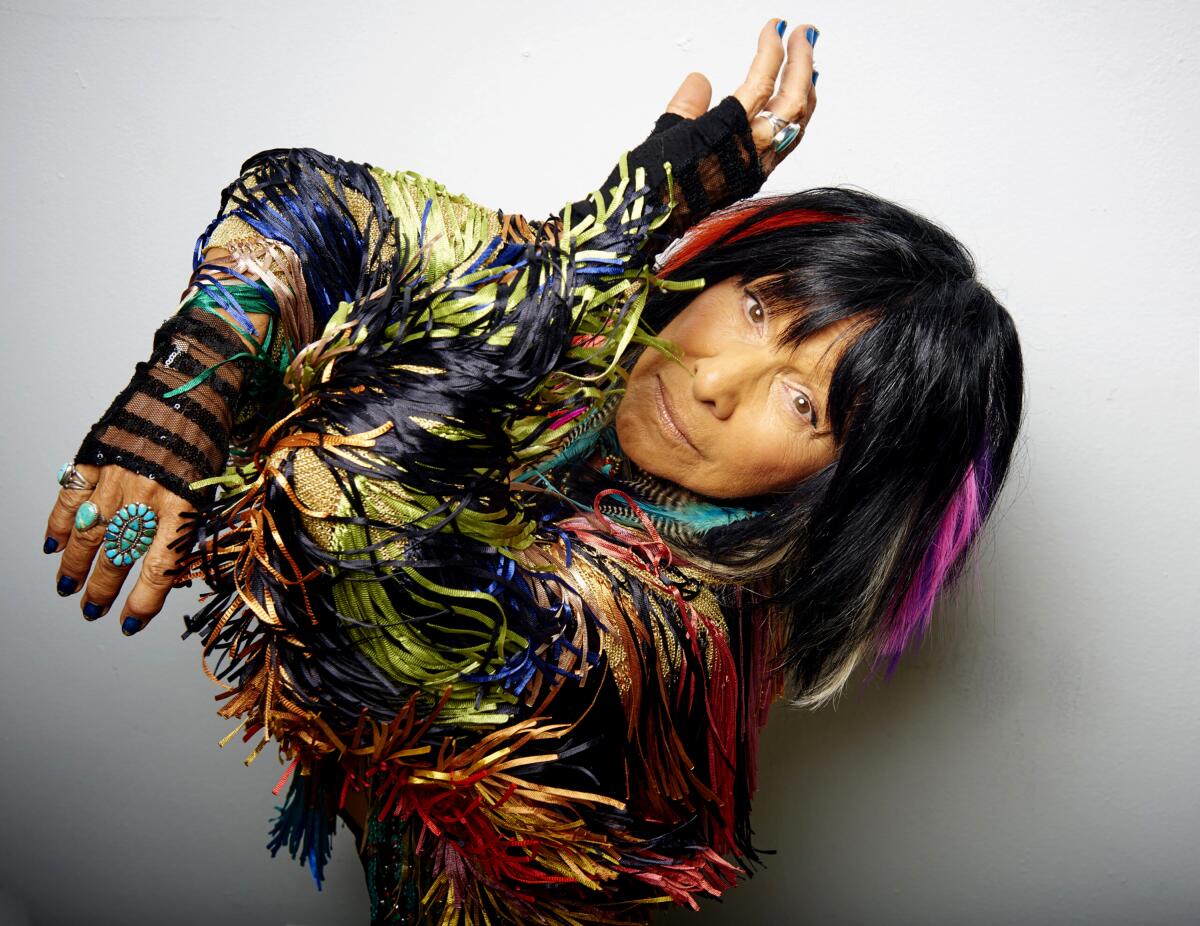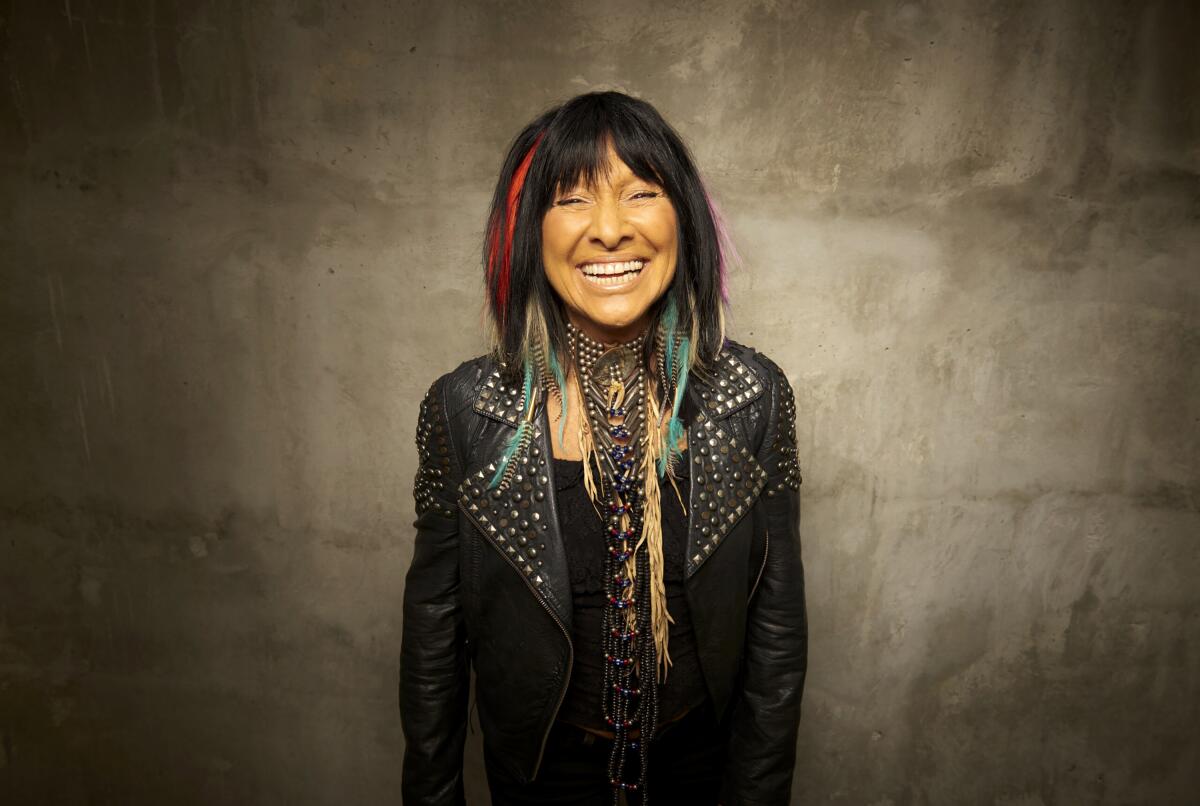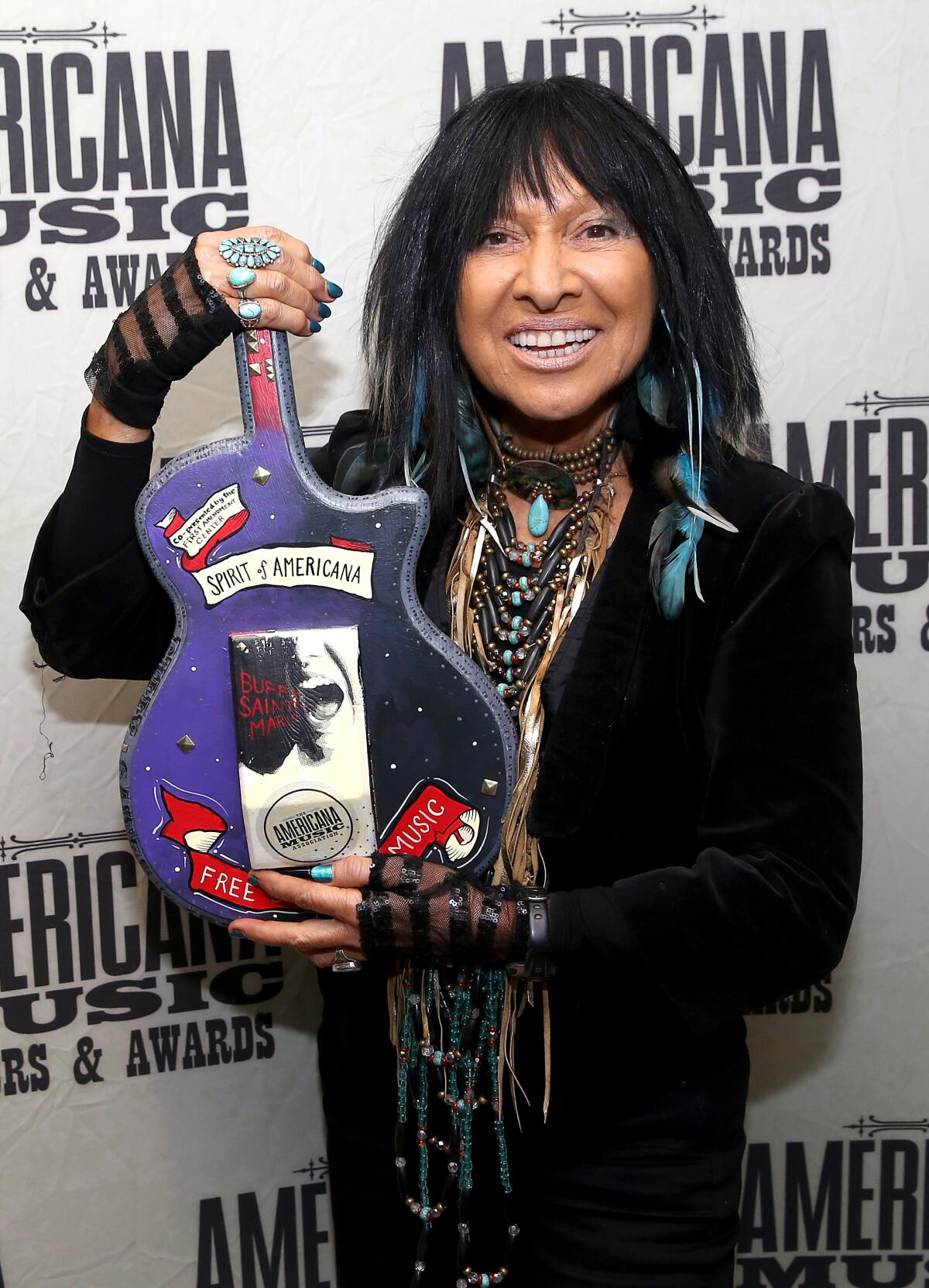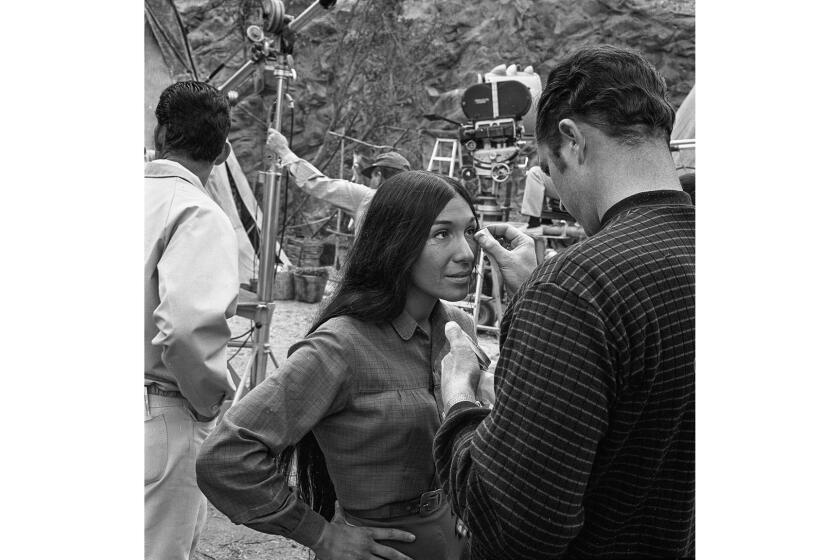Buffy Sainte-Marie reclaims her story in ‘Carry It On’

The coffeehouse musicians that were the dominant force in the U.S. during the folk-heavy 1950s and early ’60s have been experiencing a mini-renaissance lately. It started with excitement over Joni Mitchell’s return to the stage, then Bob Dylan‘s new museum and book and now a documentary spotlighting one of the era’s top voices as “Buffy Sainte-Marie: Carry It On” hits PBS on Tuesday.
The 81-year-old Canadian Cree Nation singer’s career has spanned the decades with huge hits in the ’60s like “The Universal Soldier,” “Cod’ine” and “Until It’s Time for You to Go,” through her Oscar-winning tune, “Up Where We Belong,” in 1983 and even to 2015, when her “Power in the Blood” album was named the winner of the Polaris Music Prize. Her songs have been covered and rerecorded by many artists including Donovan, Joe Cocker, Janis Joplin, Barbra Streisand and Glen Campbell. Her activism on behalf on Indigenous people has never wavered, and she’s also an accomplished visual artist as well.
For the record:
5:18 p.m. Nov. 27, 2022In an earlier version of this article, music manager Manny Greenhill was incorrectly transcribed as Manny Greenfield.
In 1969, she made one of the world’s first electronic vocal albums; in 1983, she became the first and only Indigenous person to win an Oscar; and she spent five years on “Sesame Street” where she became the first woman to breastfeed on national television.
When popular folk singer Buffy Sainte-Marie accepted a lead role in one episode of “The Virginian,” she demanded that additional Native Americans be hired.
Despite all of this, she’s not as well known today as many of her contemporary peers — mainly because one man decided to try to silence her musical and activist influence: J. Edgar Hoover.
The former FBI director blacklisted Sainte-Marie as her protest songs gained more and more popularity. She didn’t know that it had happened for about 20 years until a deejay “told me that he had letters on White House stationery commending him for having suppressed my music.”
The obstacle may have stymied her career in the U.S., but Sainte-Marie does not blame the FBI or the government for the sabotage.
“Some might think I must hate the U.S. government ‘because they destroyed her career.’ No, it’s not the U.S. government. See, that would have been legal. They would have had to pass an act of Congress against me or other singers. They did not do that. It was all done under the table by private citizens — cronies of whichever administration was in power at the time.”
The Times spoke with the singer-songwriter about her life and career, her groundbreaking scene on “Sesame Street” and what people still need to understand about Indigenous people ahead of the American Masters PBS documentary.

The early ’60s coffeehouse music scene in Greenwich Village and other places was incredible. Can you describe the vibe between the musicians?
Oh, gosh. I wasn’t much a part of the scene. If you weren’t in Albert Grossman‘s stable or Harold Leventhal’s stable or Manny Greenfield‘s stable, you were like the rest of us. I mean, you knew Bob Dylan, Joan Baez and Peter, Paul and Mary. They had huge careers going. But people like me and Phil Ochs and Tom Paxton and Odetta — we were there, but it was quite different for us. For instance, we were not invited to a lot of the big photo ops for civil rights, and the big famous people, they were not showing up for Indigenous rights. But you know who was showing up for Indigenous rights? Muhammad Ali and Ken Norton and Stevie Wonder.
[The scene] was really about youth, music, etc. But it was compromised very early on so that the public would see us through a certain business filter, which left out a whole lot of other people unless you really get into it. So what I’m saying is, it was bigger [than it seemed]. The famous people were only the tip of the iceberg. It was really very wonderful, very cool.
I mean, there’s excitement even now that Joni Mitchell is going to perform next year, and she’s featured prominently in the documentary. You helped her and others get their careers off the ground. Do you still keep in touch?
I had not been in touch much at all over the years, but I went to visit [ Mitchell] a couple of years ago and we hung out and we had fun and we talked. Since that time, she called me up just after she saw the documentary, and she was just 100% better than when I had seen her two years ago. The recovery is really incredible. It’s wonderful. It’s remarkable and it’s fast. And God bless Brandi Carlile.
You were on J. Edgar Hoover’s hit list. Can you expand on what you felt when you found out? You didn’t know initially?
No, they don’t tell you! I didn’t know for 20 years. I just thought “that don’t last forever.” You’re lucky if you have a career that lasts a year. So I just figured, OK, I was having fun in every other country except the U.S. I just thought “Oh, well, the U.S. is very competitive. Music business is competitive. And that was my turn. Now it’s somebody else’s turn.” So I didn’t know anything. Sometime later I told my lawyer, and he said, “Well, we’ll get your FBI files.” And I didn’t even think I had any. But sure enough, I did.

It obviously affected your career, though. You’ve said in a few interviews that the government basically tried to put you, and the Native American movement, out of business, right?
It was kind of heartbreaking. It didn’t make me angry because Lyndon Johnson and Richard Nixon were both dead by then. It was very heartbreaking, though, that the messages that I thought people would love to know about had been stopped. I had virtually been gagged, and I didn’t know. I was very famous on the East Coast and on the West Coast, but in Indian Country, none of us got to play. I mean, who was it who was running the college music concert series? Who was it who owned the newspapers? Who controlled television and radio? It was energy companies — very prominent, high up in the social ladder, people. So it was heartbreaking because I really feel as though we could have been more effective if our stories could have been known at the time.
So you weren’t angry at the government?
Nooo! I’m glad you asked because that gives me a chance to correct something that’s out there on the internet. People might think “Oh, Buffy must hate the government.” It wasn’t the government. It was done under the table by private citizens. They go in the backroom and they make nasty phone calls to the media, to the networks and to the radio stations. It’s all done privately. So you can’t blame the government. It’s a handful of guys elected for a few years, and they pretty much have the reins of power. Lyndon Johnson was a Democrat and Richard Nixon was a Republican. And I was under surveillance during both.
Did that have anything to do with you taking 16 years off?
No, actually, I took 16 years off to raise my son. But, of course, with no career in the U.S., I wasn’t traveling in the U.S. If something’s not happening, not percolating in show business, well there’s a lot more to life than just show business. I’m an artist. So there’s the art side of it, then there’s when you have to go on the road and sell it. So I love staying at home. I’m in a real happy life in spite of all kinds of people taking swings at me. I’m just plain not a fighter. I just don’t fight. I go and do something interesting instead.
OK, let’s talk about your years on “Sesame Street.” The shows that were done in Hawaii and the Native American family introduced on the “Street” were big moments, but the breastfeeding episode was also a first on TV. Can you break down the behind-the-scenes of that moment?
Well, here’s the thing. I just coincidentally happened to have just given birth, so I was nursing my baby and I was nursing him off camera. I had a nanny with me at the time and when I had to go on camera, I handed my little baby over to my nanny. So everybody was used to the fact that I was breastfeeding. That was no big deal at all. Nobody thought anything of that. And then the night before we actually did the breastfeeding segment, I talked to Dulcy Singer, one of the founders and producers for “Sesame Street.” I mentioned to him “Why don’t we just do it?” And we wrote it right up and we did it the next day. And so it was never controversial back then, but now it’s controversial. Somebody will put it on YouTube, and somebody will take it down. I don’t get it. In general, my experience on “Sesame Street” was absolutely the best thing I’ve ever done. They were genuinely child-centered and child-friendly. They never stereotyped me to be “the ‘Sesame Street’ Indian” or anything like that. We did sibling rivalry and multiculturalism and ordinary things like counting and letters. And I wrote a love song for the letter A.

You mention in the documentary that “at a certain point, I realized that the timing was off” for your career. When did that realization come?
Oh, gosh, I think probably around the time I realized that my career had been deliberately drowned. Probably around the same time that I found out about the rest of the FBI surveillance and that kind of thing. I just realized that it’s not as though I’m saying things or making music that people hate. It’s just being kept quiet and invisible. And I realized that the reason for that is that I think, I also said in the documentary, that sometimes you have to carry the medicine for a very long time.
My life has been a real combination of high education and zero education. Super flashy city education — Paris, lights, camera, action — to really quiet and reserved reservation life, being with Aboriginal people in Australia as well as the rest of the population. And I think that just gives you a different kind of insight. My songs have been almost closer to what you do than to what Sting is doing or Paul Simon. It’s kind of journalism, in a way. It’s [also] the art of a three-minute song. Sometimes you get lucky and you can sum things up nicely in three minutes, but that doesn’t mean that the world is ready for it.
How was the process of working with director Madison Thomas, laying out your life for the documentary?
Oh, it was good. Andrea [Warner] wrote the biography about me, authorized biography, and she’s the writer on this movie. So it’s like the fourth time that I’ve seen people lay out my life, each time a little differently. Andrea and I have really become friends over the years since she first wrote the book. So it was very comfortable. Madison Thomas, she’s a crackerjack! She’s half Indigenous and she’s from Manitoba. She’s winning all kinds of awards — she just got the Director Guild Award in Canada. Yes. So it was really fun, really easy.
November is Native American Heritage Month. What is it that people still need to know and understand about issues facing Indigenous people?
Let me start by saying the good news about the bad news is that more people know about it. Indigenous people in the world have an imposed legal handicap. It’s unknown to other human beings just because of this 15th century doctrine of discovery, which is embedded into today’s United States and Canadian law and in the law of all countries colonized by Europeans. So we’re still vulnerable to legal horrors, invasion, slavery, profiteering, obligatory conversion and death. And the doctrine of discovery from 1452 says that explorers coming upon inhabited lands were instructed by the pope — and I’m reading — to invade, capture and subdue the inhabitants and to reduce their persons to perpetual slavery and to appropriate to himself and his successors all of their lands, kingdoms, possessions and goods, and to convert them to his youth and profit. And people will say, “Well, that’s old and toothless.” But it’s not — it’s still on the book throughout all of the colonized countries of the world, including Canada and the U.S.A. Even Ruth Bader Ginsburg used it in 2005 to defeat the Oneida tribe, although later she said she regretted it.
‘American Masters: Buffy Sainte-Marie: Carry It On ’
Where: PBS
When: Tuesday, 9 p.m.
Rating: TV-14 (may be unsuitable for children under the age of 14)
More to Read
The complete guide to home viewing
Get Screen Gab for everything about the TV shows and streaming movies everyone’s talking about.
You may occasionally receive promotional content from the Los Angeles Times.








